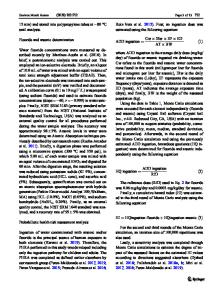Phthalates in House and Dormitory Dust: Occurrence, Human Exposure and Risk Assessment
- PDF / 588,976 Bytes
- 6 Pages / 595.276 x 790.866 pts Page_size
- 28 Downloads / 336 Views
Phthalates in House and Dormitory Dust: Occurrence, Human Exposure and Risk Assessment Shen Xu1,2 · Chao Li3 Received: 31 July 2020 / Accepted: 19 November 2020 © Springer Science+Business Media, LLC, part of Springer Nature 2020
Abstract Phthalates are one of ubiquitous contaminants in the indoor environment. In this study, we analyzed concentrations and profiles of 9 phthalates in dust samples collected from houses and university dormitories in Nanjing, China. The total concentrations of phthalates in house and dormitory dust ranged from 111.4 to 3599.1 µg/g and 86.1 to 1262.3 µg/g, respectively. Phthalates in house was significantly higher than that in dormitory dust (p 98%. Deuterium-labeled standards (DMP-d4, DBP-d4, BzBP-d4 and DEHP-d4) were purchased from the Cambridge Isotope laboratories (Andover, MA, USA). HPLC-grade dichloromethane (DCM) and n-hexane (Hex) were purchased from Merck (Darmstadt, Germany). We collected 50 indoor dust samples in Nanjing city, China from June to September in 2016. Detailed information for sampled houses was provided in Supporting Information (Table S1). Among the samples, 27 dust samples were collected from houses, and 23 samples were collected from graduate dormitories in Nanjing University, Xianlin Campus. Dust samples from floor of living rooms and bedrooms were collected by vacuum cleaner. The vacuum cleaner was precleaned before each sampling. The dust samples were packed in clean aluminum foil and sent to laboratory immediately after sampling. Dust samples were homogenized, sieved through 150 µm stainless sieve, and stored at − 20°C until analysis.
13
The concentration and detection rate of the target phthalates in house dust were presented in Table 1. DNHP and DCHP were found in 63% and 78% of the house dust analyzed, respectively. The rest seven phthalates (DMP, DEP, DiBP, DBP, BzBP, DEHP and DNOP) were detected in all house dust. The total concentrations of phthalates in dust varied from 111.4 to 3599.1 µg/g with median value of 713.3 µg/g (Table 1). High detection rates and high levels of phthalates in house dust indicated that these chemicals were widely used in consumers’ products and lead to high human exposure to phthalates through house dust. Among the phthalates analyzed, DEHP, DBP and DiBP were the three most abundant compounds in house dust. The concentration of DEHP ranged from 23.5 to 2838.5 µg/g with median value of 397.3 µg/g, which was 2.6 and 7.7 times higher than the concentration of DBP (range 17.6–666.8 µg/g, median 152.7 µg/g) and DiBP (range 9.6–242.3 µg/g, median 51.5 µg/g), respectively. The total concentration of the other six congeners was only 1.4–13.8 µg/g (median 4.3 µg/g), and was generally 1–2 orders of magnitude lower than the total concentrations of three dominant compounds (Table 1). The composition profiles of phthalates in house dust were present in Fig. 1. DEHP accounted for 5.9%–96.5% (average: 62.9%) of the total concentrations of phthalates, which was similar to the production volumes of DEHP. As reported, DEHP accounted f
Data Loading...











